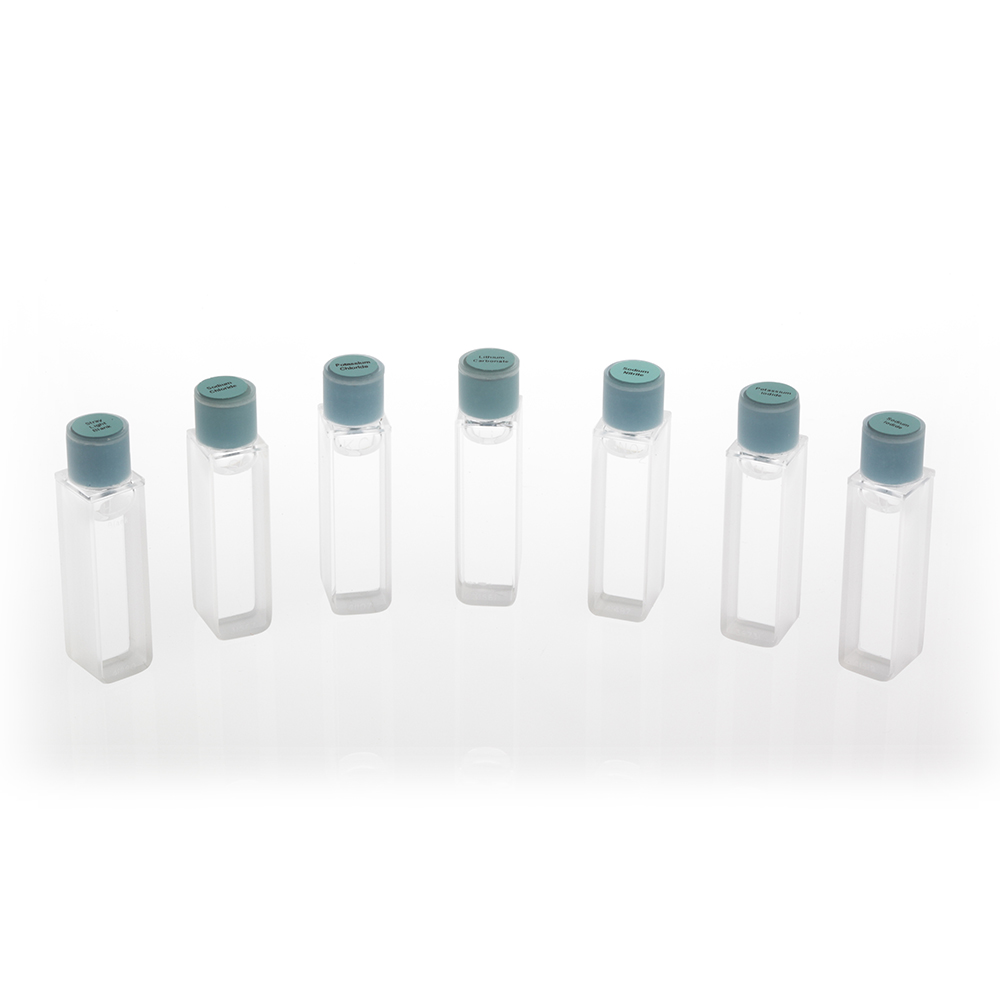Purpose
These Reference Materials can be used to qualify the stray light (or Stray Radiant Energy) of Ultraviolet (UV) spectrophotometers according to the ASTM 387 Specified Wavelength Method. This method is accepted for instrument qualification by the US and European Pharmacopoeias.
Description and Discussion
A range of liquid cut-off filters that allow stray light to be checked at a range of wavelengths from 175 to 385 nm. Starna liquid stray light references are supplied permanently sealed by heat fusion into 10 mm high quality far UV quartz cells. Starna alkali halide stray light Certified Reference Materials (CRMs) are prepared in accordance with ASTM International E-387
Stray light, also called Stray Radiant Energy or Power, is any light reaching the detector that is outside the bandwidth selected for analysis by the monochromator. It can be due to optical imperfections or stray reflections within the monochromator itself or to light leaks or other effects in the rest of the optical system. As the detector cannot discriminate between the analytical wavelength and the stray light, the stray light contributes to the detector signal and introduces an error in the measured absorption. The stray light is not absorbed even at high concentrations of the absorbing species, so its effect is a negative deviation from the linear relationship between concentration and absorbance (the Beer-Lambert law) on which most quantitative determinations are based.
Stray light is wavelength and instrument dependant. It can be present at any wavelength but is most noticeable when the energy throughput of the system at the analytical wavelength is relatively low, for example in the far UV region, and any stray light will be comparatively more significant. At these wavelengths, any deterioration in the instrument optics or UV light source will exaggerate the apparent stray light, so It is desirable to check it even if the instrument is not to be used in the far UV, as it is an excellent way of monitoring the condition of the instrument optics.
The usual way of assessing stray light is to measure, at the desired analytical wavelength, a sample that totally absorbs the radiation at that wavelength, but transmits at all otherwavelengths. Any light detected by the instrument is then stray light.
Practically, the usual method is to use cut-off filters orsolutions that cut off all light near the analytical wavelength,and transmit at all higher wavelengths. Starna stray light CRMs have very sharp transitional (cut-off) spectra, giving excellent filtering characteristics. The certified wavelength is that at which the spectrum transitions 2.0 A. Below thiswavelength, within the indicated usable range, any indicationof light transmission must be stray light
Typical spectra

| Material | CONCENTRATION | Cut-off | Usable range | Catalogue Number |
|
Sodium Nitrite |
5% aqueous |
391 nm | 300 - 385 nm | RM-SN |
|
Acetone |
Spectroscopy grade |
326 nm | 250 - 320 nm | RM-AC |
|
Potassium Iodide |
1% aqueous |
260 nm | 210 - 259 nm | RM-KI |
|
Sodium Iodide |
1% aqueous |
260 nm | 210 - 259 nm | RM-SI |
|
Lithium Carbonate |
Saturated aqueous |
227 nm | 210 - 225 nm | RM-LC |
|
Sodium Chloride |
1% aqueous |
201 nm | 175 - 200 nm | RM-SC |
|
Potassium Chloride |
1.2% aqueous |
201 nm | 175 - 200 nm | RM-KC |
Several of these filters are recommended for instrument qualification by Pharmacopoeias and other standardisation bodies, including the US and European Pharmacopoeias. To comply with these specifications, when measured against a water blank at the recommended wavelength the measured absorbance should be not less than given in the table:
| Material | CONCENTRATION | USP Recommended wavelength | USP Absorbance
|
EP Recommended wavelength | EP Absorbance
|
|
Potassium Chloride |
12g/l |
198 | ≥ 2.0 | 198 | ≥ 2.0 |
|
Sodium Iodide |
10g/l |
220 | ≥ 2.0 | 220 | ≥ 3.0 |
|
Potassium Iodide |
10g/l |
220 | ≥ 2.0 | 250 | ≥ 3.0 |
|
Sodium Nitrite |
50g/l |
340 | ≥ 2.0 | 340 and 370 | ≥ 3.0 |
|
Acetone |
Spectroscopy grade |
300 | ≥ 2.0 | not listed | not listed |



